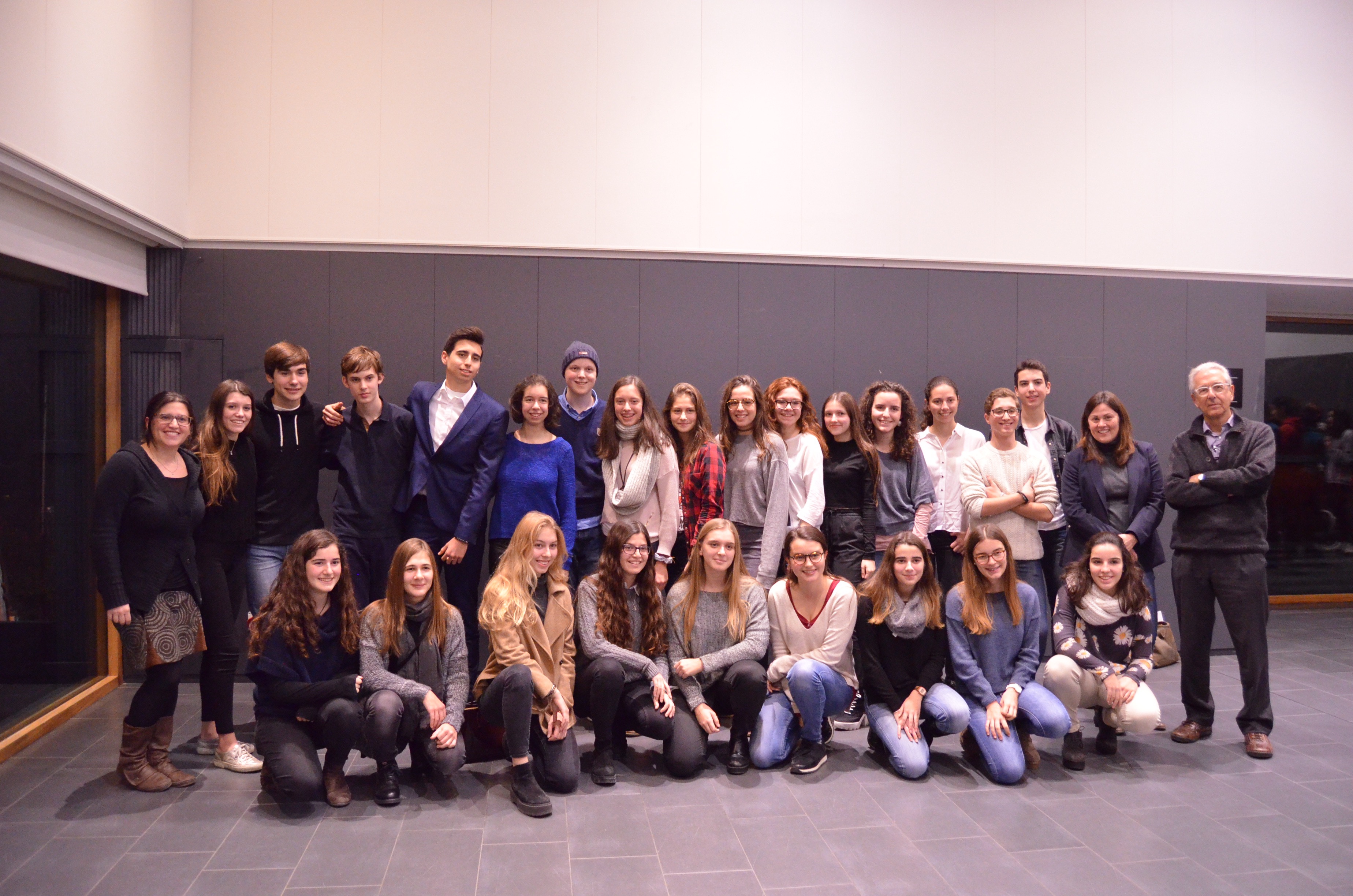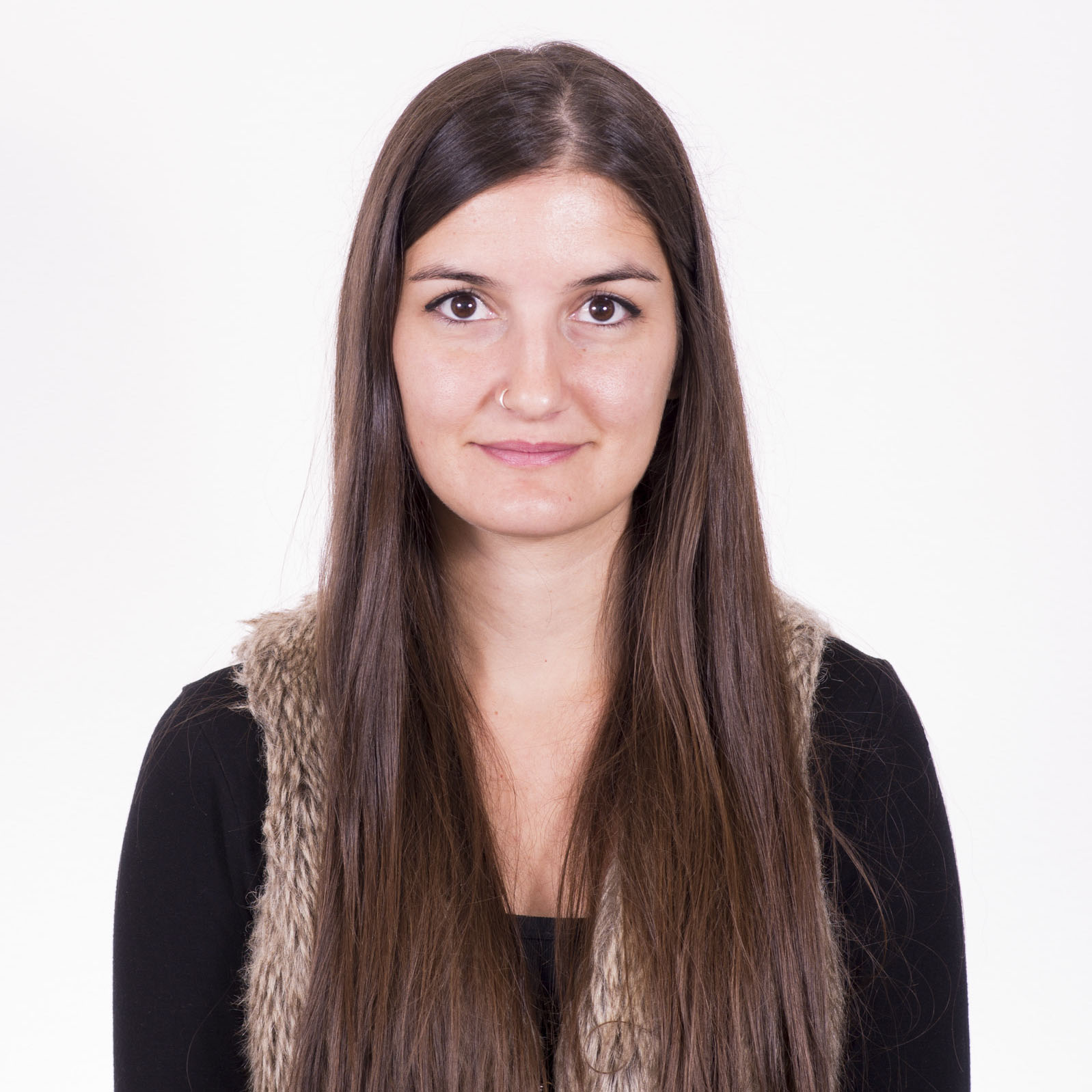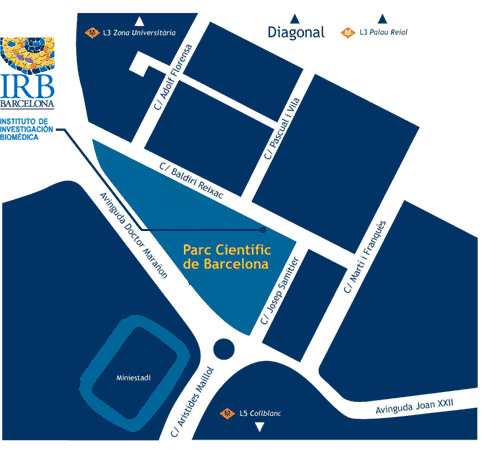Organized by IRB Barcelona in collaboration with the Fundació Catalunya – La Pedrera.
This year's tutors: Sanja Zivanovic, Ricardo Viais, Nina Schweizer, Mark McCully, Núria Gutiérrez, Jordi Badia, Marion Salzer, Jorge García, Susanna Barros, Daniela Kalafatovic, Lada Murcia, and Celia Santos.
Presentation

Participants of the “Crazy About Biomedicine” 2017 course.
Objectives
Crazy About Biomedicine is a course directed at students in their first year of baccalaureate who wish to explore some of the exciting discoveries being made in the life sciences. Through this course, students will have a chance to deepen their knowledge of scientific theory and techniques in the field of biomedicine. They will work alongside our young researchers to get a taste for what doing science in a top international research institute is like, gain some hands-on experience in the latest cutting-edge methodologies, and position themselves for a potential career in the life sciences.
Course Description
A year-long workshop in the life sciences for high-school students organized by IRB Barcelona within the series "Crazy About Science" of the Fundació Catalunya – La Pedrera.
This course includes a combination of theoretical lectures and practical hands-on experimental activities, which take place on 18 Saturdays throughout the year. Presented by IRB Barcelona PhD students and postdocs, the course will cover 12 hot scientific topics, ranging from cell and molecular biology to structural and computational biology, and chemistry. In the first ‘semester’ (January-June 2017), the first three Saturdays will be devoted to these general lectures for all participants. During the following six sessions, small groups will enter the labs for hands-on practical experience. This schedule will then be repeated with six new research topics in the second semester (June-December). Participants must commit themselves to attending the whole course.

Course language
All lectures and practical sessions will be conducted in English.
Course dates and times
The course will run from January to December 2017, 10.00-14.00h.
SEMESTER I
- Fri. 13 January 2017: Inauguration at Mon Sant Benet- Sant Fruitós del Bages
- Sat. 14 January: Talk 1
- Sat. 21 January: Talk 2
- Sat. 4 February: Talk 3
- Sat. 18 February: Practical session 1
- Sat. 4 March: Practical session 2
- Sat. 18 March: Practical session 3
- Sat. 1 April: Practical session 4
- Sat. 22 April: Practical session 5
- Sat. 29 April: Practical session 6
SEMESTER II
- Sat. 20 May: Talk 1
- Sat. 3 June: Talk 2
- Sat. 17 June: Talk 3
- Sat. 16 September: Practical session 1
- Sat. 30 September: Practical session 2
- Sat. 21 October: Practical session 3
- Sat. 28 October: Practical session 4
- Sat. 11 November: Practical session 5
- Sat. 25 November: Practical session 6
Course fees
There is a fee of 120 euros to contribute to administrative and insurance costs for this programme, payable directly to the Catalunya–La Pedrera.
Account number: ES65 0081 0556 7900 0190 7396 (Banc Sabadell)
Concept: BXC1605 + Name and Surname + ID number (DNI)
Deadline: Before 11 December, 2016. Before 20 December, an email will be sent confirming the receipt of the deposit.
Lunches and snacks are not provided. Students will receive a Certificate of Participation upon successful completion of the course at a special ceremony in January 2018, to which parents and teachers will be invited.
Course location
Institute for Research in Biomedicine (IRB Barcelona)
C/ Baldiri Reixac, 10
08028 Barcelona
Who can apply
This course is directed toward students in the first year of their baccalaureate, who have a special interest and talent in the fields related to the life sciences (primarily biology and chemistry).
Students may apply to a maximum of 2 programmes within the "Crazy About Science" series, and can participate in only one.
How to apply
 Interested students must fill in the online application form and include a letter of motivation. A letter of recommendation will be requested directly from two of their teachers, who should know the applicant well. If the applicant has recently changed school then the letters of recommendation should be requested from his/her former teachers. The deadline for registration is Sunday, 23 October 2016.
Interested students must fill in the online application form and include a letter of motivation. A letter of recommendation will be requested directly from two of their teachers, who should know the applicant well. If the applicant has recently changed school then the letters of recommendation should be requested from his/her former teachers. The deadline for registration is Sunday, 23 October 2016.
The course is open to a total of 24 students. Candidates will be selected on the basis of their academic record, teacher recommendations and motivation to participate. A short list of candidates will be invited for interviews with the scientific organizers in November after which the final selection will be made. Students will be informed of the outcome by the first week in December. The students selected to participate and their parents/guardians will be asked to sign a letter of commitment to attend all sessions.
Collaborators
Facebook: @catfundacio
Twiter: @catfundacio
Instagram: #bojosperlaciencia @catfundacio
Facebook: @youthscience.barcelona
Twiter: @youthsciencebcn
Instagram: @youthscience.barcelona

![]()

If you have any question, please contact us at: irb_outreach@irbbarcelona.org
Important dates
 23 October 2016: Application deadline
23 October 2016: Application deadline- Week of 7 November 2015: Short-listed candidates contacted
- 14-25 November 2016: Interviews
- Week of 28 November 2016: Selected students contacted
- 1-5 December 2016: List of selected candidates published
- Fri. 13 January 2017: Inauguration at Món Sant Benet –Sant Fruitós del Bages
- Sat. 14 January 2017: Course begins
- Mon. 27 November 2017: Closing Ceremony
Programme
SEMESTER 1
1. Rational drug design
Sanja Zivanovic (Molecular modelling and bioinformatics)

The typical drug discovery and development cycle, from concept to market, takes approximately 14 years and can cost up to 1 billion euros. This process could be vastly improved by combining scientific knowledge and powerful computational methods. Such an approach aims to identify the damaged protein that causes illness and also find hits and possible inhibitors, thus reducing the labour costs and the time-consuming process of drug discovery.
Students will be introduced to the fundamentals of molecular modelling and will have the opportunity to practise drawing 2D and 3D structures. They will learn how to manipulate atoms and molecules, set up correct charge, and analyse optical activity. We will go through various molecular visualization software packages, namely Avogadro, VMD, and Pymol, and perform graphical representations of molecules. To be able to use the above-mentioned software, students will be provided with the necessary computational tools such as a command line in Linux. The skills acquired in this tutorial will help them to carry out more drug discovery calculations in the second semester.
2. Stepping into the world of the cell skeleton
Ricardo Viais and Nina Schweizer (Microtubule organization)


The cytoskeleton is a cellular compartment present in all domains of life. As its name suggests, it is the “skeleton” of the cell, ensuring its shape and migration. In eukaryotic cells, one of the components of the cytoskeleton is the microtubule—a tiny tubular structure that forms a network throughout the cytoplasm. Microtubules can be considered LEGO, where the basic individual bricks are dimers of a protein called tubulin. The microtubule network is extremely dynamic, and the addition or removal of tubulin “pieces” from microtubules leads to their growth or shrinkage. In fact, microtubules are much more than just a “skeleton of the cell”. They are also involved in chromosome segregation during mitosis and meiosis and they serve as highways for the transport of organelles and key molecules inside the cell. Microtubules are one of the targets of cancer treatment and have also been shown to be involved in neurodegenerative diseases (like Parkinson’s and Alzheimer’s).
In this practical course we will learn how microtubules are formed, how they grow, and what they look like in different cell types and distinct cell cycle stages. For this purpose, we will use cultured cell lines, mouse hippocampal neurons, and fluorescence light microscopy techniques.
3. Gateway to the brain: Creating peptides to cross the blood brain barrier and deliver therapeutics
Mark McCully (Design, synthesis and structure of peptides and proteins)

The human body has numerous barriers that serve to ensure a stable environment for our cells and to protect us from disease. Our skin, the mucous lining in respiratory system, and tears from our eyes are all examples of barriers designed to safeguard our wellbeing.
The brain is an extremely complicated organ and as such it too has a highly complex barrier to shield it against viruses, bacteria and chemicals. Called the Blood-Brain Barrier (BBB), this system is of the utmost importance to keep our brains healthy. However, the BBB is not totally impenetrable, and some external agents are able to cross it and invade the brain. This is the point at which problems truly start for doctors and their patients. The BBB is so complex and selective that sending traditional drugs to target the disease does not work. Therapeutic agents simply do not have the capacity to cross the BBB, thus resulting in high mortality rates for brain diseases.
Our lab is focused on developing peptides (short sequences of amino acids) that can cross this barrier and transport a drug of interest to the site of the infection. During this course we will synthesise peptides, attach a “therapeutic” cargo and assess the capacity of these constructs to cross the BBB.
4. Study of therapeutic drugs that trigger apoptosis in cancer cells
Núria Gutiérrez (Signalling and Cell Cycle Laboratory)

Apoptosis is a form of programmed cell death that is required for organisms to grow and develop properly and to maintain body tissues. This process is initiated when a cell is damaged or infected. DNA damage or oncogene expression, among other stimuli, can induce cell cycle arrest through the activation of special proteins involved in cell cycle checkpoints. When arrested, DNA damage can be repaired and the cell cycle can re-start. If damage persists, cells undergo apoptosis.
A hallmark of human cancer is the intrinsic or acquired resistance to cell death. Cancer cells are able to bypass apoptosis by altering the mechanisms that detect damage or abnormalities. This means that proper signalling does not occur. As a result, unrepaired damage accumulates, giving rise to mutations that allow cells to become malignant. This knowledge has been exploited for the purpose of therapy design. Several anti-cancer drugs impair the DNA damage response, thereby leading to the accumulation of cytotoxic damage, which eventually gives rise to apoptosis. However, different kinds of cancer show distinct behaviours, and the response to these chemotherapeutic drugs varies in function of the cell type.
In this practical course we will treat various cancer cell lines with several chemotherapeutic agents used in clinical practice and test their responses. To detect cell death, we will use one of the most famous techniques in molecular biology, namely Western blot. In parallel, we will learn about other techniques used in this field such as immunofluorescence and immunohistochemistry. These techniques will allow us to appreciate the differences between distinct cancer cells and why therapy design is such a complex process.
5. Targeting the Tumour Microenvironment in colorectal cancer metastasis
Jordi Badia (Colorectal cancer laboratory)

Colorectal Cancer (CRC) is the most common cancer and the second leading cause of cancer-related deaths in Spain, according to the AECC (Asociación Española Contra el Cáncer). CRC produces cancers in the large intestine through a multi-step process that, like many other types of cancer, starts with the acquisition of mutations in key genes. These mutations then go on to make cells proliferate without control. CRC can be easily treated if detected early. However, we still need to find effective treatments for the most advanced stages of cancer, particularly for metastasis—the final and deadliest step of cancer, which in the case of CRC occurs mainly in the liver.
The great potential of cancer cells resides not only in their capacity for mass proliferation but also in their ability to trick the healthy cells surrounding them. Fibroblasts, cells of the immune system, and blood vessels form what we call the tumour microenvironment (TME), which protects cancer cells from being removed and facilitates their invasion of other healthy organs. Our laboratory has recently shown that the TME is crucial for the aggressiveness of CRC and formation of metastasis in the liver. We are now channelling efforts into studying the potential of the TME as a way to block metastasis and into identifying novel treatments.
In this practical course we will provide an overview of several in vivo models and histological tools. Using these tools, we will discover and target those cells that form the TME of liver metastasis, with the aim to learn how to exploit them and stop the CRC metastasis.
6. When cells go wild: Cancer stem cells and their microenvironment
Marion Salzer (Stem cells and cancer)

Throughout life our skin regenerates in order to maintain a functional barrier between our body and the external environment. To do so, epidermal stem cells continuously divide, and their offspring differentiate into functional skin barrier cells, which eventually die and are shed. The processes of stem cell division, differentiation, and death are tightly regulated. Extensive cell division may lead to the formation of a tumour, while extensive cell death compromises the barrier function of skin.
The skin contains a variety of cell types, such as dermal fibroblasts, endothelial cells, and immune cells, which control the behaviour of stem cells by secreting growth-promoting or growth-inhibiting signals. These cells form the so-called “stem cell niche”. Occasionally, a stem cell acquires a mutation that allows it to divide in an uncontrolled manner. If this mutation goes undetected by the microenvironment, it will lead to the development of a tumour. The same cell types that are found in healthy skin are also found in skin tumours, but their behaviour differs. Cancer stem cells hyperproliferate, and the cells in the surrounding niche permit or even enhance this process.
During our practical session we will use cell cultures of primary tumour cells isolated from mice to study the interaction between tumour cells and tumour-associated fibroblasts. We will deplete a gene that is highly expressed in tumour-associated fibroblasts compared to normal fibroblasts and examine its effect on tumour cell behaviour.
SEMESTER 2
1. Regulation of gene expression or why we don't understand our genome (yet)
Manuel Cañete (Translational control of cell cycle and differentiation)

In the year 2000, the Human Genome Project was completed at a cost of around 3 billion dollars and ten years of intense work. The main conclusion was that over 98% of our genetic material was junk DNA. Far from resolving our questions, by reading our genome it became apparent that we didn't understand it. Since then, mounting evidence has made us realise that understanding our genome means understanding how its expression is regulated.
We are now starting to gain some insight into how cells depend on extremely complex regulatory networks to switch genes on and off through a myriad of novel players such as microRNAs, long non-coding RNAs, and RNA-binding proteins. Unravelling the mechanisms underlying the regulation of gene expression will be vital to understand how an erythrocyte and a neuron differ while sharing the exact same genes or why in identical twins one falls ill with a disease like cancer while the other remains completely healthy.
In this course we will use in vitro cell culture systems and look at the current methods that researchers apply to study the regulation of gene expression.
2. Stepping into the world of proteins
Jorge García (Structural biology of protein & nucleic acid complexes and molecular machines)

Proteins form the very basis of life. They regulate a variety of activities in all known organisms, from replication of the genetic code to oxygen transport, and are generally responsible for regulating cellular machinery and determining the phenotype of an organism. Proteins accomplish their tasks in the body by three-dimensional (3D) interactions between various substrates. The functional properties of proteins depend upon their 3D arrangement. The 3D structures arise because particular sequences of amino acids in a polypeptide chain fold to generate from linear chains to compact domains with specific organizations. The folded domains can serve as modules for larger assemblies or provide specific catalytic or binding sites.
Various technologies, such as X-ray crystallography, are used to disclose protein structures. This particular technique calls for the use of crystals, a material whose constituents (in this case proteins) are arranged in an ordered pattern that extend in all three spatial dimensions. Crystals subjected to this technique, scatter the x-rays, and the information collected can help to infer the protein structure.
In this course, we will use the bacteria Escherichia coli to produce a protein of interest. We will use this same protein to make crystals and observe how a real protein crystal looks like!
3. Understanding the relevance of mitochondrial dynamics in metabolic disease
Susana Barros (Complex metabolic diseases and mitochondria)

Age-related metabolic diseases have increased to epidemic proportions over the past century in all industrialized countries. The prevalence of diabetes mellitus and glucose intolerance increases significantly with age. Mitochondrial dysfunction has been reported in complex age-related diseases, as well as in aging itself.
Mitochondria are essential organelles for converting nutrients into usable and storable energy in the form of ATP through different processes such as oxidative phosphorylation, Krebs cycle and fatty acid oxidation. For that mitochondria displays an ability to modulate their architecture through a dynamic process of fusion and fission in order to adapt to the energetic needs of the cell. It had been described that defects in mitochondrial dynamics leads to mitochondrial function impairments contributing to a variety of human diseases.
Preliminary studies in our group showed that the in vivo hepatic ablation of Mfn2, responsible for mitochondrial fusion, led to numerous metabolic abnormalities.
In this practical session students will be introduced to techniques of gene silencing in vitro as a tool to mimic the in vivo model and its relevance in research. Students will also have access to histological studies from different in vivo models and infer differences between normal and knockout mice.
4. Identifying new membrane receptors using combinatorial chemistry
Daniela Kalafatovic (Design, synthesis and structure of peptides and proteins)

Cancer continues to be one of the main causes of death worldwide. Current therapeutic approaches have limitations in that they are not sufficiently specific, effective or localized not are they efficient against metastasis. Metastasis accounts for 90% of all cancer deaths in patients with solid tumours. Preventing metastasis in high risk patients is still the main challenge in cancer medicine.
Recently, specific genomic mutations have been associated with bone metastasis in breast cancer patients. By exploiting this finding, new diagnostic tools for identifying patients at high risk can be developed using a combinatorial chemistry approach. The objective is to identify new membrane receptors associated with specific genomic mutations and clarify the differences between cells with or without metastatic potential. For this purpose, we use peptides bound to resin beads and screen them in various cancer cell lines.
In this course we will address how to build small peptide libraries and how to characterize them. In order to find new binders for cell surface receptors, we will then incubate cancer cells with the peptides and study their interactions.
5. Study of tumorigenesis using flies
Lada Murcia and Celia Santos (Development and Growth Control Laboratory)


Cancer is a multi-hit process that involves mutations in oncogenes and tumour suppressors. It is characterized by the uncontrolled proliferation of malignant cells and invasion to adjacent healthy tissue. The most common type of human tumour, carcinoma, is of epithelial origin. Aggressive cancer cells activate a programme named EMT (Epithelial to Mesenchymal Transition), which causes them to undergo morphogenetic alterations, finally leading to acquisition of invasive motility. Over the last decade, the fruit fly Drosophila melanogaster has become a key model system for cancer research. This model has the advantage that the signalling pathways are conserved between flies and humans, genome redundancy is reduced compared to humans, and a wide range of powerful genetic tools are available.
In this course, we will give an overview of Drosophila genetics and present how we use this model system to characterise aspects of tumorigenesis, such as cell proliferation and cell invasion, at the molecular and cellular levels. In particular, we will focus on the “wing imaginal disc” —simple mono-layered epithelia that grow about 1000-fold in mass and cell number during larval development—. In this regard, we will perform in vivo dissections of this tissue and immunohistochemistry of the samples to analyse the signalling pathways involved in some aspects of tumorigenesis.
6. Study of tumorigenesis using flies (This course is a continuation from the previous)
Lara Barrio (Development and Growth Control Laboratory)

Cancer is a complex disease driven by the accumulation of mutations and epigenetic changes that alter intrinsic cellular functions and cell-cell interactions in tissues. The conservation of signalling pathways and cellular regulatory systems between humans and flies has made Drosophila melanogaster a useful model in which to explore different types of cancer. Indeed, many human oncogenes and tumour-suppressor genes were originally discovered in Drosophila.
In this second part of the course, we will continue to use the "imaginal discs" to study some aspects underlying tumour initiation and progression. We will analyse the previous dissected samples by confocal microscopy, process the images with specific software and finally do a statistical analysis.
Venue
CRAZY ABOUT BIOMEDICINE will take place at the IRB Barcelona facilities.

Institute for Research in Biomedicine (IRB Barcelona)
Parc Cientific de Barcelona
C/ Baldiri Reixac, 10
08028 Barcelona
(Campus de la Diagonal, Universitat de Barcelona)

